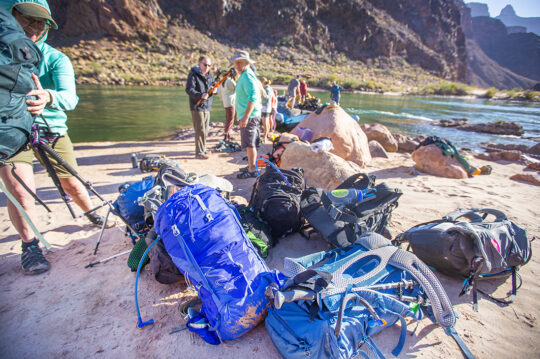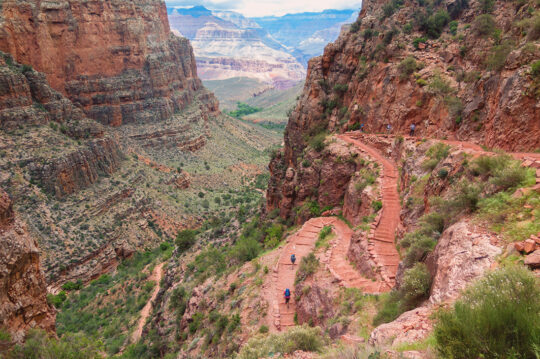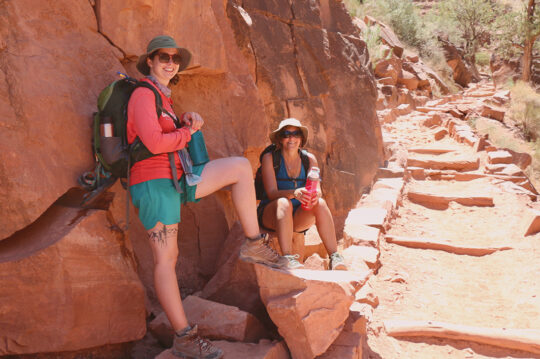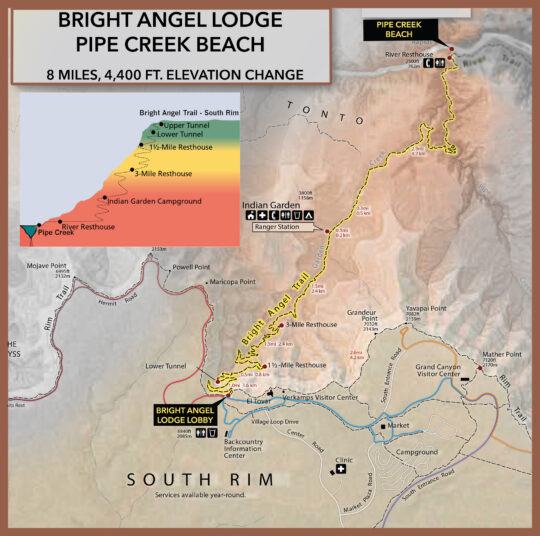Trip Info: Hike Info
Backpack
You will need to pack all of your personal gear into an internal frame hiking backpack. The pack should have a hip belt and a sternum strap and should be as small as possible. Many people use a 35-liter pack (or smaller); it should not exceed 44 liters.
Hiking backpacks are highly adjustable; make sure yours is fitted properly before using it. When you are packing for your hike, make sure your food and water are easy to access. Load your lightest gear at the bottom of the pack, your heaviest gear next to your back and centered in the pack, and your medium-weight gear toward the top and outside of the pack.

The Hike Out
On the last morning of your trip, you will be up extra early for breakfast and to prepare for the hike out of Grand Canyon. We will provide lunch and snacks for the hike out. You will raft the last few miles of your river expedition to Pipe Creek Beach where your hike begins. We find the best combination for carrying water is a hydration bladder and a one-liter bottle used to mix electrolyte drinks; make sure to have two liters capacity total. There are rest houses where you can refill water and use the restrooms. It is recommended to refill at every water station. A guide will be hiking on the trail behind the group but will not expect everyone to hike together. If you need assistance, wait on the trail for the hiking guide to catch up to you. If you hike faster than the guide, they will assume you are doing well, and you do not need to wait at the top to check in with them.
The Trail
You will hike the Bright Angel Trail from the river to the South Rim – a distance of about 8 miles with an elevation gain of 4,400 vertical feet. The hike out averages a steep 10% grade, is similar to an extended StairMaster workout and takes the prepared hiker 6-8 hours or more. The trail is maintained, but it is very long, ALL UPHILL, and tops out around 7,000 feet above sea level. Some of the hardest portions of this hike are near the end where many tall steps can be taxing on your already tired legs. There is little shade, and the weather is normally extremely hot and dry making this hike even more strenuous. When you encounter pack mules on the trail, make sure to step off the trail on the uphill side away from the edge and listen for commands from the wrangler. There are a few intersecting trails, so be alert as you hike. Do not hike along the river to Phantom Ranch!

Training
It is very important that you exercise regularly and train for this mandatory hike. We have provided a custom training program for the months leading up to your trip. Do not underestimate the rigorous nature of this hike. Activities such as cycling or swimming, while great for cardiovascular endurance, do not adequately prepare you for the strain of being on your feet all day. There is no substitute for hiking; the best way to train is to do practice hikes of similar length and elevation gain with a weighted backpack and in the footwear you’ll be using for the hike. Hiking poles are great to have and can take some stress off your legs. Even if you’ve never used poles, we suggest getting them for the hike. They are easily stored on the rafts. Depending on how prepared you are, your hike can be an accomplishment to top off your river trip or a challenging ordeal. The difference between a great adventure and a trip to the hospital is up to you!

Hiking Tips
Please print this map and bring it with you. Additional tips from Grand Canyon National Park can be found here.
EAT OFTEN & STAY HYDRATED – Eat more than you normally do, ensuring you eat before, during, and after your hike. No matter what the temperature, you need water and energy to keep going. Every hour hiking in the canyon can be likened to the physiological equivalent of shoveling wet sand. You need to eat about twice as much as you normally would to meet your energy needs while hiking in the heat of the Grand Canyon. Your best defense against illness and exhaustion is eating breakfast, consuming salty snacks, and alternating drinking water and electrolyte drinks throughout your hike.
STAY WET & COOL – Whenever you are near water, make sure you get your head and shirt wet to cool down. A wet bandana or sarong on the back of your neck can help lower your body temperature.
DO NOT HUFF & PUFF – Walking at a pace that allows you to walk and talk means that your legs and your body are getting the oxygen needed to function efficiently. At times it may seem like you are walking too slow (sometimes even baby-sized steps when the trail is steep), but your energy reserves will last longer. Take breaks and enjoy the view!

